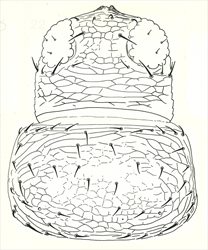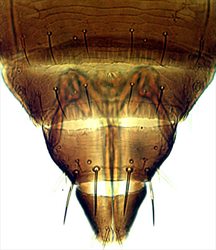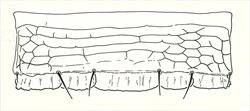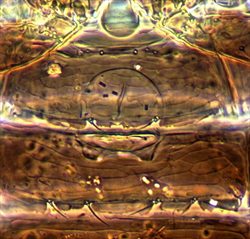
Female

Female & male

Antenna

Antenna

Head & thorax

Head

Head & pronotum

Female tergites VII-X

Abdominal sternites IV–VI

Sternite IV

Male tergites VIII-IX

Male glandular opening between sternites II and III
Both sexes without wings, and uniformly dark brown. Antennae 8-segmented but VI with an incomplete oblique suture producing an apparently 9-segmented condition; segments III–IV with sense cone simple. Head weakly reticulate; ocelli not developed, ocellar setae III as long as diameter of three ommatidia; maxillary palps 3-segmented. Pronotum with no long setae. Tergites with transverse reticulation medially, tergites I–VIII with well-developed craspedum on posterior margin. Sternites III–VI with well-developed 5-lobed craspedum, the sternal posteromarginal setal pair S3 arising at the posterolateral angle of each of the sternites.
Male smaller and paler than female, sternite II with an internal glandular structure opening through an aperture on the antecostal margin of segment III; tergite IX with 2 pairs of short stout thorn-like setae.
There are only two species of Apterothrips, of which A. apteris is essentially a southern hemisphere species whereas A. secticornis is essentially a northern hemisphere species (Mound & Marullo, 1996). These two are distinguished by the number of lobes on the craspeda of the abdominal sternites, but are otherwise very similar. The males share with those of several Neotropical Thripidae species the character state of having a single glandular area on the anterior margin of the third abdominal sternite.
Feeding and breeding on the leaves of its host plants, and usually associated with Poaceae. However, this thrips has been found causing damage to garlic and to lucerne in Australia, and large populations have been recorded in California from Erigeron [Asteraceae].
In Britain, recorded twice in Scotland, at Ayr and Fair Isle (Morison, 1973a), and twice in England, in West Yorkshire and Devon (Collins, 2000a; 2010a), but otherwise not known from Europe. The species is widespread around the southern hemisphere from Mexico, Peru, and the Falkland Islands, to Australia and New Zealand, and is also known from Hawaii. The British records are therefore geographically aberrant. It was previously misidentified as secticornis, a species that, by contrast, is reported across Europe and the northern Holarctic, but is not known from Britain.
THRIPIDAE - THRIPINAE
Apterothrips apteris (Daniel)
Sericothrips apteris Daniel, 1904: 295
Sericothrips stanfordii Moulton, 1907: 51
Sericothrips ineptus Ahlberg, 1922: 271
Apterothrips delamarei Bournier, 1962: 231
Collins DW (2000a) First English record for Apterothrips apteris (Daniel) (Thysanoptera: Thripidae). Entomologist’s Monthly Magazine. 136: 210.
Collins DW (2010a) Thysanoptera of Great Britain: a revised and updated checklist. Zootaxa 2412: 21–41.
Morison GD (1973a) Observations and records for British Thysanoptera. XVI. Thripidae, Apterothrips secticornis (Trybom), a species new to Britain. Entomologist’s Monthly Magazine 109: 208–210.
Mound LA & Marullo R (1996) The thrips of Central and South America: an introduction (Insecta: Thysanoptera). Memoirs on Entomology, International 6: 1–487.